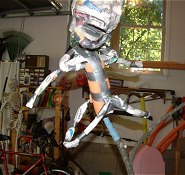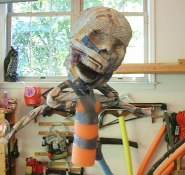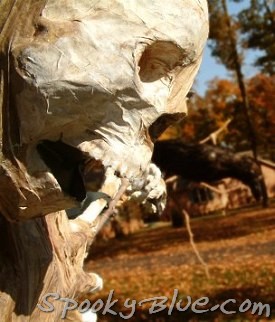
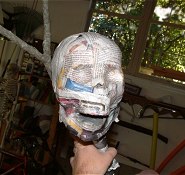
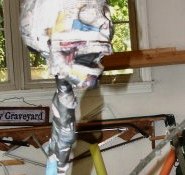
Okay, why the long neck?
There are two reasons:
1) So we'll have plenty of area to secure it to the stick.
2) I's always a good idea to have plenty of wiggle room. Where exactly are the shoulders going to go? Beats me, but we've left ourselves options.
I know what you're thinking. Why not just build the body and attach it to the stick? Well, give it a shot and let us know how it went. The stick will make a great spine, and I liked the image of monster and tree melded together.
If you decide to skin your tree, then consider covering the branch that's going to hold the body before going any further. When you're ready, secure the neck to the tree and don't spare the duct tape. By the way, he looked like he had a TV antenna sticking out of his head, so I lopped off the "rabbit ears".
Build the torso
Now we're back in familiar territory. Crow's torso is standard zombie-issue. A hunk of foam pool noodle serves as a spacer between the branch (spine) and the area to which all the rib bones will be attached (sternum). I've also made spacers of plastic juice bottles, a cardboard box, and wadded newspaper. Anything that's fairly rigid.
The spacer adds a great deal of strength to the torso, and gives you more control over the barrel shape of the rib cage. A bucky that lives in our garage was an invaluable reference for this part, but a few skeleton pictures are almost as good.
Roll 'dem bones
Each rib is three full sheets of newspaper tightly wrapped and banded with duct tape. Extend the mileage on a roll of duct tape by tearing several pieces to about five inches, then ripping them into thirds.
I've found that if I twist the paper after rolling it (like you're wringing out the wash cloth that you used to clean the cat barf off your favorite chair -stupid cat), the resulting newspaper bone is much stronger. Of course, you'll have claws for fingers after rolling an hour's worth of ribs, clavicles, humeruseses, and so forth.
I have to wonder if all this paper rolling will contribute to a future arthritic condition. Rolling newspaper bones is my least favorite part of these projects. Anyone who presents your old pal Spook with a good alternative gets a special prize.
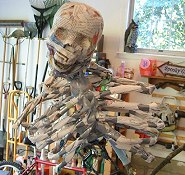
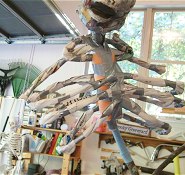
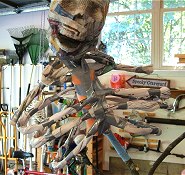
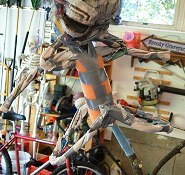 These pictures represent several thousand words worth of skeleton building.
These pictures represent several thousand words worth of skeleton building.
There's no real science to it. Attach a bone to the sternum, wrap it around to resemble a rib, and tape it to the back.
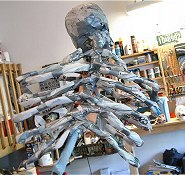
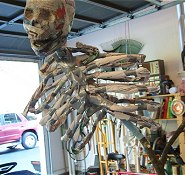 1) Human ribs point downward and get smaller the closer they get to the pelvis. You can spend a lot of time adding all the other extra fiddly bits that actually make up the rib cage. I was otherwise compelled.
1) Human ribs point downward and get smaller the closer they get to the pelvis. You can spend a lot of time adding all the other extra fiddly bits that actually make up the rib cage. I was otherwise compelled.
2) Now is a good time to figure out your arm situation, and this is where I goofed. More info to follow, but suffice it to say that by Halloween night, Crow was more interested in pointing out groundhogs than beckoning tasty prey items.
3) If some of your ribs float around too much for comfort, tie them together from the back with a few strips of duct tape. Keep these "runners" away from any exterior areas if you're going to leave a few un-skinned bones sticking out.
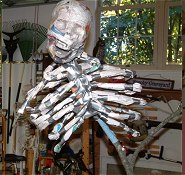
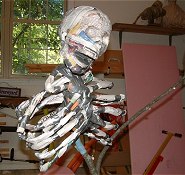
4) See that "collar" around the neck? We'll call it the clavicle due to its location, but it's the anatomical equivalent of a camel's hump merged with a chimney. Crow utilizes this as sort of a flying buttress between the spine and shoulder. Actually, I suppose it's more like the tower of a suspension bridge.
In any case, it's responsible for holding up the shoulders and will play a major role when it comes time to attach the arms. Your clavicle should be thick and firmly welded to the spine.
5) Your brigand's "character" will emerge at about this stage. Don't stifle it. If his head likes being cocked at an angle, don't straighten it. If he wants one shoulder hunched over, better let him have it.
Much like mutant Jack-o-Lanterns, a brigand likes to get his way. Fighting it for any reason except to keep the whole contraption from flipping over and scratching the family truckster is misspent effort.
6) You can go the extra mile and try for super-realism if you like, so have at it. Just bear in mind that, according to census data of the US Labor Department and the American Medical Association, medical doctors comprise about 0.29% of the US population. A misaligned mandible probably won't be noticed. Your call.
